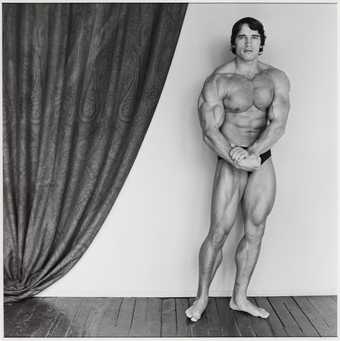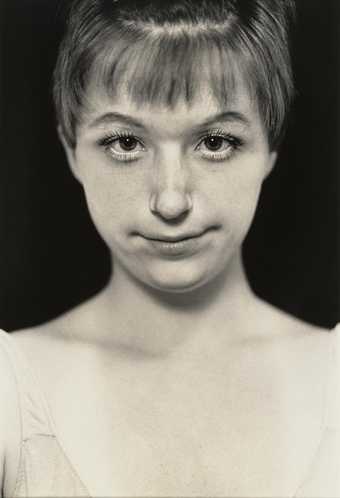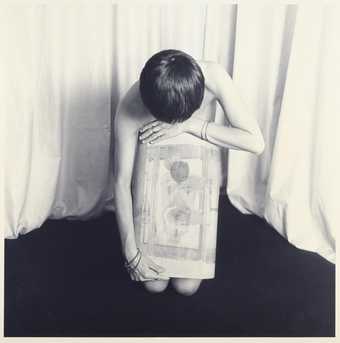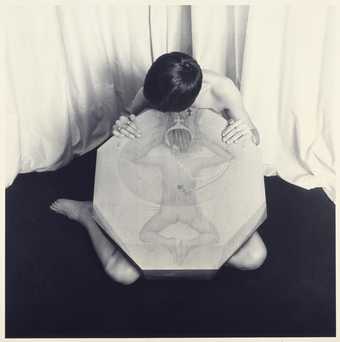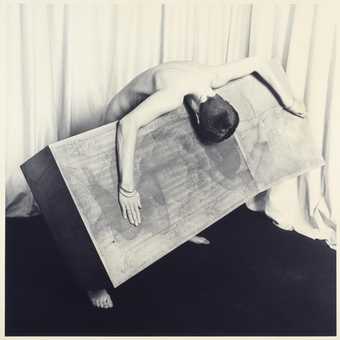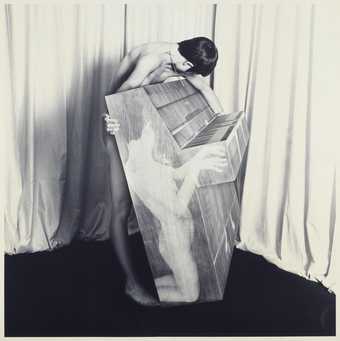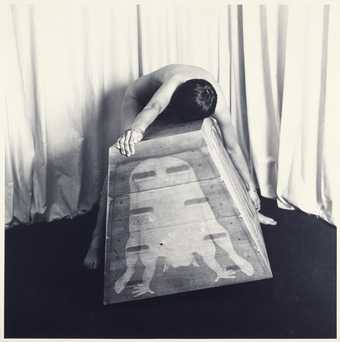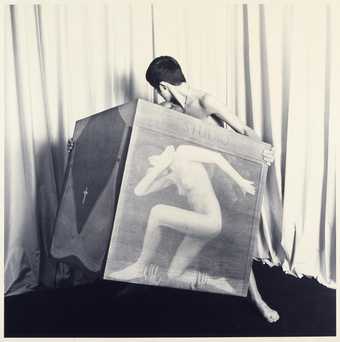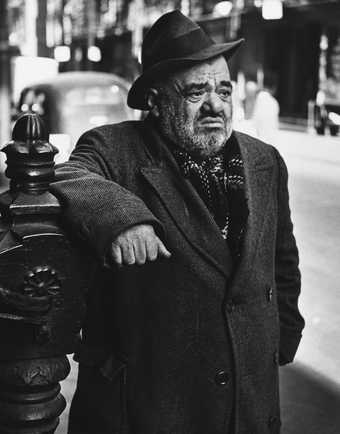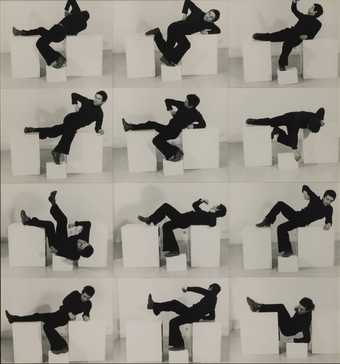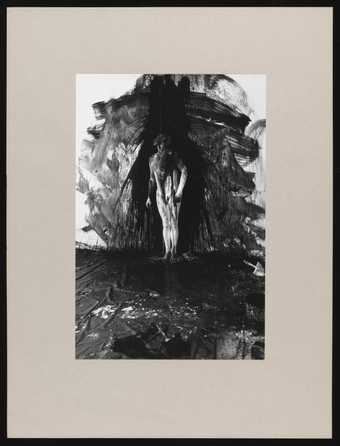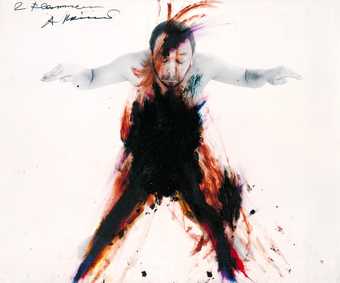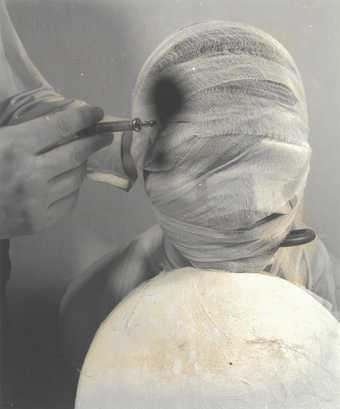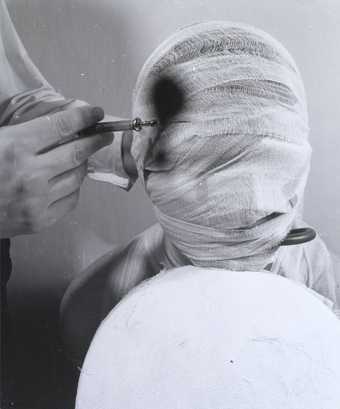
Not on display
- Artist
- Rudolf Schwarzkogler 1940–1969
- Original title
- 3rd Aktion
- Medium
- Photograph, gelatin silver print on paper
- Dimensions
- Image: 600 × 500 mm
- Collection
- Tate
- Acquisition
- Purchased 2002
- Reference
- T11848
Summary
This is one of a series of approximately sixty-eight black and white photographs which constitute Schwarzkogler’s 3rd Action. It depicts a naked man, partially wrapped in gauze bandages, lying on a white sheet on the floor next to the wall. His body is folded in on itself uncomfortably as though it is enclosed in a small space; his head and right arm are pushed up against the wall, his right knee is bent in to his chest under his body and his left leg extends to the bottom edge of the picture frame. The bandaging is chaotic and unravelling in places such as his left thigh, where a strip of sticking plaster has been ripped off the skin and hangs down to his knee. The sheet is pinned to a rectangular board over which it is pulled taut. A tangle of black cord partially trapped under the body snakes over the board. The ground below the sheet appears black. In the background, at the upper edge of the image, a pile of paper and plastic wrapping lies on the black floor.
Schwarzkogler is one of four Viennese artists who grouped themselves under the title Wiener Aktionsgruppe, or the ‘Vienna Action Group’, in 1965. Hermann Nitsch (born 1938), Otto Mühl (born 1925) and Günter Brus (born 1938) created ritualistic performances or Actions aimed at releasing repressed desires and bringing about a state of cathartic awareness through acts which often subverted traditional authorities and broke taboos. The Actions were initially conceived in relation to the activity of painting. Paint and organic substitutes for paint, such as blood and food, are common materials used in combination with the artists’ and performers’ bodies. Despite individual differences, the members of the group frequently collaborated and performed in each others’ Actions. Ludwig Hoffenreich, a well known Viennese press photographer, documented Actions by all members of the group during the 1960s and 70s. Schwarzkogler was particularly attracted to the work of early Austrian Expressionists such as Egon Schiele (1890-1918) and Oskar Kokoschka (1886-1980), the more recent French artist Yves Klein (1928-62) and the Viennese artist Arnulf Rainer (born 1929). He created a total of six Actions, five in 1965 and one in 1966. Although the first, Wedding, was performed in front of an audience, Schwarzkogler found it so distracting that he staged all subsequent actions purely for the camera. His use of a clinical white background and his careful arrangement of the constituents of each photograph distinguish his work from that of the other Actionists, for whom the experience of public performance was the principal goal. An extreme aesthetic simplicity, complemented by photographing in black and white rather than in colour, and the repetition of props and themes, confer a formal clarity on his images.
Schwarzkogler’s father was a medical doctor and his mother a cosmetician. He studied at the Graphische Lehr- und Versuchsanstalt (The Pedagogical and Experimental Institute for Graphics) in Vienna (1957-61), where he met the artist Heinz Cibulka (born 1943) and later Nitsch, who introduced him to Brus and Mühl. Cibulka served as the principal model for Schwarzkogler’s 2nd, 3rd and 4th Actions, all of which took place in Cibulka’s apartment on Kaiserstrasse in Vienna. In these Actions, such oppositions as evisceration and stuffing, castration and bandaging appear in ambiguous relation to each other. Mutilation, injection, the ingestion of fluids from bottles, claustrophobic wrapping and blinding all confuse the relationship between healing and pain. The 3rd Action repeats and develops much of the imagery introduced in the 2nd Action, which features the artist as a utensil-wielding ‘doctor’ acting on a passive ‘patient’ (see Tate P78691). Only Cibulka appears in the 3rd Action. New elements include the whitening of Cibulka’s body and face with some kind of cosmetic, and the introduction of a bundle of snaky black cord and a board covered in a white sheet on which Cibulka lies, first naked with his penis bandaged and white lines drawn on his limbs and chest and then partially wrapped in bandages like a mummy. Geometric forms – the round white ball, the rectangular black mirror, the rectangular board under the white sheet which is pulled taut over it – are combined with the organic structures constituted by the human body and its wrappings, the various fish and the bundle of writhing black cord. Dramatic lighting emphasises the contrasts between white and black and enhances the sinister, claustrophobic atmosphere.
Schwarzkogler’s 2nd, 3rd and 5th Actions
were photographed exclusively by Ludwig Hoffenreich (died 1975). Many of the photographs were printed posthumously in portfolios created collaboratively by Archiv Conz and the Krinzinger Gallery, Vienna, in 1973, 1975 and 1980. This is a unique print created in the early 1970s. Schwarzkogler’s partner, Edith Adam (1943-1996), and Hoffenreich followed the artist’s detailed instructions to determine the cropping of the print from its original square format.
Further reading:
Directions: Rudolf Schwarzkogler, exhibition brochure, Hirshhorn Museum and Sculpture Garden, Washington D.C. 1996.
Eva Badura-Triska, Hubert Klocker, Rudolf Schwarzkogler: Leben und Werk, exhibition catalogue, Museum moderner Kunst Stiftung Ludwig, Vienna 1993, reproduced p.201.
Viennese Actionism Vol.1 1960-1965: From Action Painting to Actionism, exhibition catalogue, Museum Fridericianum, Kassel, Kunstumseum Winterthur and Scottish National Gallery of Modern Art, Edinburgh 1988.
Elizabeth Manchester
September 2003
Does this text contain inaccurate information or language that you feel we should improve or change? We would like to hear from you.
Explore
- emotions, concepts and ideas(16,416)
-
- emotions and human qualities(5,345)
-
- suffering(161)
- formal qualities(12,454)
-
- photographic(4,673)
- universal concepts(6,387)
-
- menace(209)
- clothing and personal items(5,879)
-
- make-up(87)
- cable(15)
- sheet(19)
- bandage(43)
- actions: postures and motions(9,111)
-
- contorted(76)
- man(10,453)
- mutilated(40)
- male(959)
- individuals: male(1,841)
- Austria(871)
- arts and entertainment(7,210)
-
- artist, multi-media(393)
You might like
-
Robert Mapplethorpe Arnold Schwarzenegger
1976, printed 2005 -
Cindy Sherman Untitled C
1975 -
Helen Chadwick The Labours I
1986 -
Helen Chadwick The Labours II
1986 -
Helen Chadwick The Labours VI
1986 -
Helen Chadwick The Labours VII
1986 -
Helen Chadwick The Labours VIII
1986 -
Helen Chadwick The Labours IX
1986 -
Lisette Model Little man, Lower East Side, New York City
1939–42, printed 1976 -
Bruce McLean Pose Work for Plinths I
1971 -
Bruce McLean Pose Work for Plinths 3
1971 -
Stuart Brisley Moments of Decision/Indecision
1975 -
Arnulf Rainer Untitled (Body Language)
c.1973 -
Rudolf Schwarzkogler 2nd Action
1965, printed early 1970s -
Rudolf Schwarzkogler 3rd Action
1965, printed early 1970s

